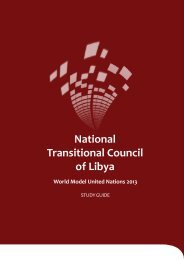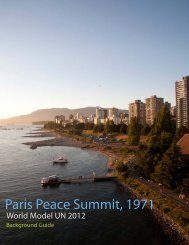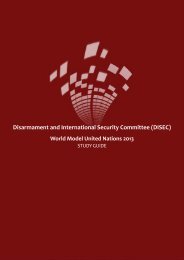Social, Humanitarian and Cultural Committee (SOCHUM)
Social, Humanitarian and Cultural Committee (SOCHUM)
Social, Humanitarian and Cultural Committee (SOCHUM)
You also want an ePaper? Increase the reach of your titles
YUMPU automatically turns print PDFs into web optimized ePapers that Google loves.
Trade Organization (WTO) suggested these actions<br />
as a means of increasing free trade globally, which<br />
would lead to substantial economic growth in the long<br />
term. This logic, however, did not take into account<br />
the negative impact that the WTO Agreement on<br />
Agriculture would bear for on indigenous populations.<br />
This impact has two distinct manifestations. The first<br />
is the flooding of international markets with large<br />
volumes of agricultural crops from the developed<br />
industries of a small number of countries, which<br />
drives down prices on these products for all countries.<br />
Without any tariff protections <strong>and</strong> exposed to the<br />
free market, indigenous farmers who grow the same<br />
crops are unable to make a suitable living with their<br />
traditional techniques. Because they do not have<br />
the resources to compete with the large agricultural<br />
companies in developed countries, they are also<br />
unable to adapt to more modern methods of farming.<br />
One of the primary producers of agricultural products<br />
for the past century has been the United States, <strong>and</strong><br />
its companies have inadvertently destroyed many<br />
indigenous industries, notably Mexico’s corn industry<br />
<strong>and</strong> the coffee industries of other Latin American<br />
countries like Brazil, Guatemala, <strong>and</strong> Costa Rica. 120<br />
Effects on local agriculture also occur when<br />
transnational companies move onto local l<strong>and</strong>s<br />
to increase their production capabilities. The<br />
transnational companies sign agreements with<br />
governments to convert “unused” l<strong>and</strong> into<br />
plantations that produce huge amounts of cash crops. 121<br />
these l<strong>and</strong>s are often not actually unused, of course,<br />
but are rather employed by indigenous populations<br />
for small-scale farming. A common view held by many<br />
majority populations <strong>and</strong> the governments that they<br />
inevitably control is that such small-scale agriculture<br />
does not contribute to economic growth <strong>and</strong> that<br />
in order to increase growth they have to turn the<br />
l<strong>and</strong> over to foreign companies that will generate<br />
profits. Even though many indigenous agricultural<br />
practices are environmentally sustainable, the<br />
majority population sees them as outdated <strong>and</strong><br />
unproductive. 122 Worse still, the crops grown by these<br />
foreign companies are almost always exclusively<br />
bound for international destinations, so they do<br />
not even help feed the indigenous populations that<br />
were pushed off of the l<strong>and</strong>. Thus, through the direct<br />
intervention of transnational agricultural companies<br />
into local farming l<strong>and</strong>s, indigenous peoples lose their<br />
livelihoods <strong>and</strong> find themselves in extreme poverty.<br />
One specific indigenous system that majority<br />
populations <strong>and</strong> governments often disrespect <strong>and</strong><br />
ignore is pastoralism. Pastoralism is a method of<br />
raising livestock on l<strong>and</strong>s that are not very good for<br />
agriculture by constantly moving the animals onto<br />
new territory in search of grazing areas <strong>and</strong> water.<br />
Approximately 25% of the world’s l<strong>and</strong> coverage is<br />
currently used for pastoralism, which accounts for<br />
10% of the world’s meat production <strong>and</strong> well over<br />
50% of the agricultural gross domestic products of<br />
many nations in Sub-Saharan Africa. 123 Pastoralism is<br />
therefore vital for the economy of Africa <strong>and</strong> is used<br />
by indigenous populations throughout the continent,<br />
including the Tuareg camel breeders in the Sahara,<br />
the Maasai cattle breeders of Eastern Africa, <strong>and</strong> the<br />
Fulani cattle breeders of the West African savannah. 124<br />
Pastoralism is thus an extremely common farming<br />
practice, usually employed by indigenous peoples.<br />
Historically, colonial governments considered<br />
pastoral l<strong>and</strong>s to be unoccupied, <strong>and</strong> many postcolonial<br />
governments have since taken control<br />
of these territories from indigenous populations<br />
for sedentary agriculture, resource extraction, or<br />
infrastructural projects. The governments take this<br />
action even though pastoralism is an extremely<br />
environmentally sustainable practice <strong>and</strong> is one<br />
of the most effective ways of utilizing dryl<strong>and</strong>s. 125<br />
Recent years have seen an increase in expulsions of<br />
indigenous populations from pastoral l<strong>and</strong>s in Sub-<br />
33<br />
Melbourne Host Directorate PTY LTD | Office of Media <strong>and</strong> Design

















